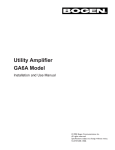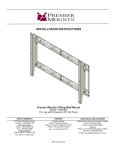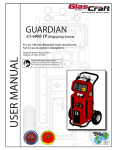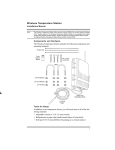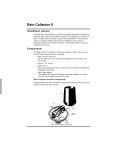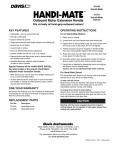Download USER MANUAL - Davis Instruments Corp.
Transcript
USER MANUAL Rain Collector with Mountable Base Product numbers 7857 and 7857M R Davis Instruments, 3465 Diablo Avenue, Hayward, CA 94545-2778 U.S.A. • 510-732-9229 • www.davisnet.com Rain Collector (#7857 & 7857M) This rain collector can be used with Vantage Pro2™ weather stations, including Vantage Pro2, Vantage Pro2 Plus, and the Anemometer/Sensor Transmitter Kit. The following instructions assume the rain collector is being used with a Vantage Pro2 or Vantage Pro2 Plus Integrated Sensor Suite (ISS). Refer to the user manual that came with your station for more information. Manuals are available online at www.davisnet.com in the Weather Support section. Note: Model number 7857 is factory-calibrated to take rain measurements in 0.01 inches. The metric version of the rain collector, number 7857M, comes factory-calibrated to take measurements in 0.2 mm. Components Please make sure you have all listed components before continuing. • Rain collector cone latched onto base • Base with tipping mechanism and 40’ (12 m) cable • U-bolt, backing plate and 2 each: lag screws, flat washers, lock washers, and hex nuts • Debris Screen •16 3.5” (9 cm) bird spikes (optional) HARDWARE KIT 14 Bird Spike Sockets RAIN CONE Debris Screen (fits snugly inside cone) U-Bolt Finger Grips 1/4" x 3" Lag Screws (~6 x 75 mm) 1/4" Flat Washers Latch TIPPING MECHANISM Bubble Level 1/4" Lock Washers 1/4" Hex Nuts 3.5” (9 cm) Bird Spikes (16) Backing Plate Metric Rain Adapter BASE 40’ Cable 1 Prepare the Rain Collector Tools and Materials Needed You may need some of the following tools and materials to install the rain collector. • Drill with 3/32” (2 mm) drill bit • Medium Phillips screwdriver • 3/16” (or 5 mm) wrench • Cable clips or weather-resistant cable ties with screw holes or other means for mounting Rain Collector Internal Components Hole in Base Tipping Spoons (Can be used to thread cable out and down) Magnet Adjustment Screw Reed Switch + - 1 2 1 Bubble Level 2 % Adjustment Guide Restraining Post Drain Screen Cable Slot Note: The rain collector is shipped with the 40’ cable coiled and exiting through one of the cable slots. You may want to uncoil the cable and feed it down through the hole in the base behind the tipping spoon. Prepare the Rain Collector 1. Remove the cone from the base by rotating the base until the latches on the cone line up with the latch openings in the base, then lifting the cone away from the base. Twist off the rain collector cone 2 Prepare the Rain Collector 2. Carefully cut and remove the plastic tie which holds the tipping spoons in place during shipping. Tipping Spoons Plastic Tie O ptional: Insert the Metric Rain Adapter The rain collector tipping spoon mechanism takes measurements in 0.01'' (US versions) or 0.2 mm (M, EU, UK and OV) increments for each tip of the spoons. If you have a US version and would like to convert it to a metric measurement, you can insert the metric adapter that is included in your hardware kit. Or, if you have a metric version and wish to convert it to take measurements in 0.01”, you can reverse these steps to remove the factory-installed metric adapter. Note: Inserting the metric rain adapter converts the rain collector to take measurements in 0.2 mm increments for each tip of the spoons. The console or Vantage Connect must be configured to 0.2 mm as well. See your console or Vantage Connect user guide for more information. To install the metric adapter: 1. Find the metric adapter included in the hardware. 2. Locate the magnet between silver-colored, V-shaped arms of the tipping spoons. 3. Open the arms slightly with one hand while pulling the magnet out with the other. 3 Prepare the Rain Collector 4. Separate an end cap from one end of the magnet. 5. Slide the magnet, exposed end of magnet first, into the open slot of the metric adapter. Top (closed) Bottom (notched) 6. Insert the metric adapter and magnet between the arms of the spoons, with the top (solid side) of the metric adapter facing up. Test the Rain Collector Before installing the rain collector, test the unit. If you are replacing a rain collector you previously installed, make a note of the total rainfall amount displayed. You may want to reenter this amount after you test the rain collector. 1. Open the transmitter shelter on the ISS. Remove the foam insert and feed the rain collector cable up through the opening. Plug the cable to the appropriate connector in the sensor interface (See illustration on page 6.) 2. Press the RAINDAY button on your console to display rainfall. 3. While watching the display on your console to see if it changes, slowly tip the bucket until it drops to the opposite side. Each tip indicates 0.01" or 0.2 mm of rain. (It may take up to a minute for the first tip to register at the console.) If the display does not change, you may be tipping the bucket too quickly. Try again, more slowly this time. If the rainfall amount displayed on the console increases by the expected increment (either 0.01" or 0.2 mm) each time you tip the bucket, your rain collector is working properly. 4 Installing the Rain Collector Installing the Rain Collector If you have not already done so, separate the cone from the base and disconnect the rain collector cable from the sensor interface in the transmitter shelter. Choosing a Location for the Rain Collector Keep the following in mind when choosing a location for your rain collector: • For accurate readings, you must mount the rain collector so that it is level. A bubble level is built-in to the base to simplify this process. • The rain collector contains a magnet-operated switch which may not operate correctly if you mount the rain collector on or near any object which is attracted to a magnet. • Exposure to winds can reduce the measured rainfall amounts. Mount the rain collector where there are no obstructions of rainfall at low angles -- such as trees, houses, fences -- and as low as possible out of the wind. • Choose a location which is easily accessible for normal cleaning and is distant from trees or other sources of heavy pollen or debris. Note: Climbing on your roof may be hazardous. If you are uneasy about installing your unit please have a qualified professional complete the installation. Davis specifically disclaims any liability for injury or loss resulting from the installation or use of the rain collector. 5 Installing the Rain Collector on a Post or Flat Surface Installing the Rain Collector on a Post or Flat Surface Refer to the following illustration to install the rain collector on a post or flat, vertical surface. Backing Plate 1/4" x 3" Lag Screws (For clairty, the tipping mechanism is not shown.) 40' Cable 1. With a 3/16" (5 mm) drill bit, drill two holes approximately 21/8" (54 mm) apart. Use the metal backing plate as a guide when marking the holes and a carpenter’s level to ensure the holes are level. 2. Remove the rain collector cone if it is installed. 3. Insert the 1/4" x 3" lag screws through the metal backing plate and the holes in the mounting base into the post. Make sure the base is level by checking the built-in bubble level. 4. Tighten the lag screws using an adjustable wrench or 7/16" wrench. 6 Installing the Rain Collector on a Pole Installing the Rain Collector on a Pole Accessories for Pole Mounting • Use the Mounting Tripod (#7716) for easy roof-mounting. • Use the Mounting Pole Kit (#7717) to raise the installation height of the rain collector by up to 37.5" (0.95 m). General Guidelines for Installing on a Pole • With the supplied U-bolt, the rain collector can be mounted on a pole having an outside diameter ranging from 11/4" to 13/4" (32 – 44mm). • A larger U-bolt (not supplied) can be used to mount to a pole with a maximum outside diameter of 21/2" (64mm). • To mount on a smaller pole, obtain a U-bolt that fits the base openings but that has a shorter threaded section. If the included U-bolt is used with a smaller pole, the bolt will interfere with the rain collector cone. • Use the built-in bubble level to ensure rain collector is level. Refer to the following illustration when installing the rain collector on a pole. 1/4" Hex Nut 1/4" Lock Washer Backing Plate Groove for U-Bolt U-Bolt Rain Collector Base 1. While holding the mounting base against the pole, place the two ends of a U-bolt around the pole and through the two holes in the base. 2. Slide the metal backing plate over the bolt ends as they stick out toward the rain collector cone. Secure the backing plate with a washer, a lock washer, and a hex nut on each of the bolt ends. Adjust the height of the rain collector, then tighten the nuts. 7 Finishing Steps Finishing Steps 1. Open the transmitter shelter on the ISS. Remove the foam insert and feed the rain collector cable up through the opening. Plug the cable to the appropriate receptacle in the transmitter. Replace the foam and close the shelter. Transmitter Shelter Sensor Interface Foam Insert 2. To be certain the rain collector is functioning properly after installation, retest the unit. See “Optional: Insert the Metric Measurement Adapter” on page 3. 3. To use bird spikes, insert one spike into each socket around the rim of the cone. The sockets are tapered: push firmly or tap lightly with a hammer for a more secure fit. 4. Place the cone back onto the base by putting the latches on the cone into the latch openings in the base and rotating the cone clockwise until the latches “lock” into place. As you reattach the cone, make sure to run the cable to the cable slot in the base, or the cone will not fit snugly against the base. (You may also run the cable down through the hole in the base.) 5. Place the debris screen, pointed end up, into the cone. The screen prevents large bits of debris from blocking the funnel hole. If bird nesting is a problem, you can place a spike in the hole on top of the debris screen. Note that using a bird spike in the debris screen may make the screen more likely to be blown over or out in a high wind gust. Be careful; bird spikes may be sharp. Note: If you choose not to install the bird spikes, we recommend that you keep the packet of spikes in case birds become a problem in the future. 6. To prevent fraying or cutting of the cable where it is exposed to weather, it is important that you secure it so it doesn’t whip about in the wind. Use cable clips or weather resistant cable ties to secure the cable. Place clips or ties approximately every 3 to 5 feet (1 to 1.6 m). Do not use metal staples or a staple gun to secure cables. Metal staples, especially when installed with a staple gun, have a tendency to cut the cables. 8 Adjusting the Rain Collector Extending Cable Runs If the cable length supplied with the rain collector is not long enough for your purposes, you may extend it. The maximum length of cable is 900 feet (274 m). To extend the cable, purchase standard 4-Conductor Extension Cables from Davis and connect them to the existing rain collector cable. Adjusting the Rain Collector The non-metric version of the rain collector is calibrated at the factory so the spoons tip (and records rainfall) for each 0.01" of rain. The metric version is calibrated so the spoons tip for each 0.2 mm. To adjust the calibration slightly, use a 3/16” (or 5 mm) wrench to rotate the adjustment screws which are located underneath the tipping spoons. (See “Rain Collector Internal Components” on page 2.) The adjustment guide embossed in the platform shows how far you must rotate both screws in turn to effect a 1% and a 2% change. Moving the screws in the positive (+) direction causes the spoons to tip more times (i.e. give a larger count) for a given amount of water. Note: Modify both adjustment screws by the same amount. To check the accuracy of the rain collector, compare the Davis rain collector with a tube type rain gauge. Use a rain gauge with an aperture of at least 4 inches. Any smaller and the readings obtained may not be accurate. Place the tube type rain gauge directly next to the Davis rain collector. Compare the totals on three storms to determine whether your rain collector needs calibration and by how much. Adjust the screws to fine-tune the reading for the next three storms if necessary. Note: Avoid comparison to rainfall readings obtained from television, radio, newspapers, or neighbors’ readings. Such readings are not an accurate measurement of the weather conditions in your specific location. The rain collector is carefully tested at the factory to conform to the specifications listed in the back of this manual. Maintaining the Rain Collector For greatest accuracy, you should thoroughly clean the rain collector at least once or twice a year. 1. Disconnect the rain collector cable from the sensor interface in the transmitter shelter. 2. Separate the cone from the base 3. Use a soft damp cloth to clean pollen, dirt, and other debris from the cone, cone screens, and bucket. 4. Use a pipe cleaner to clear the funnel hole in the cone and the drain screens in the base. When all parts are clean, rinse with clear water. 5. Reattach the cone and replace the debris screen. Reconnect the rain collector cable to the sensor interface. 9 Troubleshooting Guide Rainfall is not registering on the console or the console has a large error. • Check the cable connections from the sensor to the console. Cable connections account for a large portion of the potential problems. Connections should be firmly seated in the jacks and plugged in straight. If a reading appears intermittently on the display as you jiggle the cable, the connection is faulty. • Make sure there is no magnetic, steel, or iron object near the rain collector. • Make sure the funnel hole in the cone is clear so water can empty into the spoons. • Make sure the spoons move freely when tipping to both sides. The console should show an increase in rainfall for each tip of the spoons. (If the spoons do not move at all, check that you have cut the cable tie that holds them in place during shipping.) • Make sure the rain collector is mounted so that it is level. Contacting Davis Technical Support If you have any questions about your rain collector, please contact Davis Technical Support. We’ll be glad to help. (510) 732-7814 — Monday - Friday, 7:00 a.m. - 5:30 p.m. Pacific Time. (510) 670-0589 — Technical Support FAX. [email protected] — E-mail to Technical Support. [email protected] — General e-mail. www.davisnet.com — Davis Instruments website. Specifications Sensor Type. . . . . . . . . . . . . . . . . . . . . Tipping bucket with magnetic reed switch Output . . . . . . . . . . . . . . . . . . . . . . . . . Contact closure Attached Cable . . . . . . . . . . . . . . . . . . 40’ (12 m), 4-conductor, 26 AWG Connector . . . . . . . . . . . . . . . . . . . . . . Modular connector (RJ-11) Recommended Max.Cable Length . . . 900’ (270 m) Housing Material . . . . . . . . . . . . . . . . . UV-stabilized ABS plastic Dimensions with base, no spikes. . . . . 9.25” wide x 10.25” high x 11” deep (23.5 x 26 x 28 cm) Collection Area . . . . . . . . . . . . . . . . . . . 33.2 in2 (214 cm2) Range Daily Rainfall . . . . . . . . . . . . . . . . . 0.00” to 99.99” (0.0 mm to 999.8 mm) Total Rainfall. . . . . . . . . . . . . . . . . . 0.00” to 199.99” (0.0 mm to 6553 mm) Accuracy . . . . . . . . . . . . . . . . . . . . . . . .For rain rates up to 2"/hr (50 mm/hr): ±4% of total or +0.01” (0.2mm) (0.01" = one tip of the bucket) whichever is greater. For rain rates from 2"/hr (50 mm/hr) to 4"/hr (100 mm/hr): ±5% of total or +0.01” (0.2mm), whichever is greater. Update Interval . . . . . . . . . . . . . . . . . . . .20 - 24 seconds Input/Output Connections Red . . . . . . . . . . . . . . . . . . . . . . . . .Switch terminal Green & Yellow . . . . . . . . . . . . . . . .Switch terminal Product Number: 7857 Rain Collector Part Number: 07395.335 Rev C (11/3/15) This product complies with the essential protection requirements of the EC EMC Directive 2004/108/EC. Copyright © 2015 Davis Instruments Corp. All rights reserved. Davis Instruments Quality Management System is ISO 9001 certified. Information in this document is subject to change without notice. ® 3465 Diablo Avenue, Hayward, CA 94545-2778 U.S.A. 510-732-9229 • Fax: 510-732-9188 E-mail: [email protected] • www.davisnet.com













